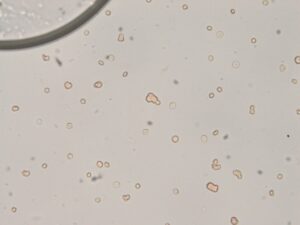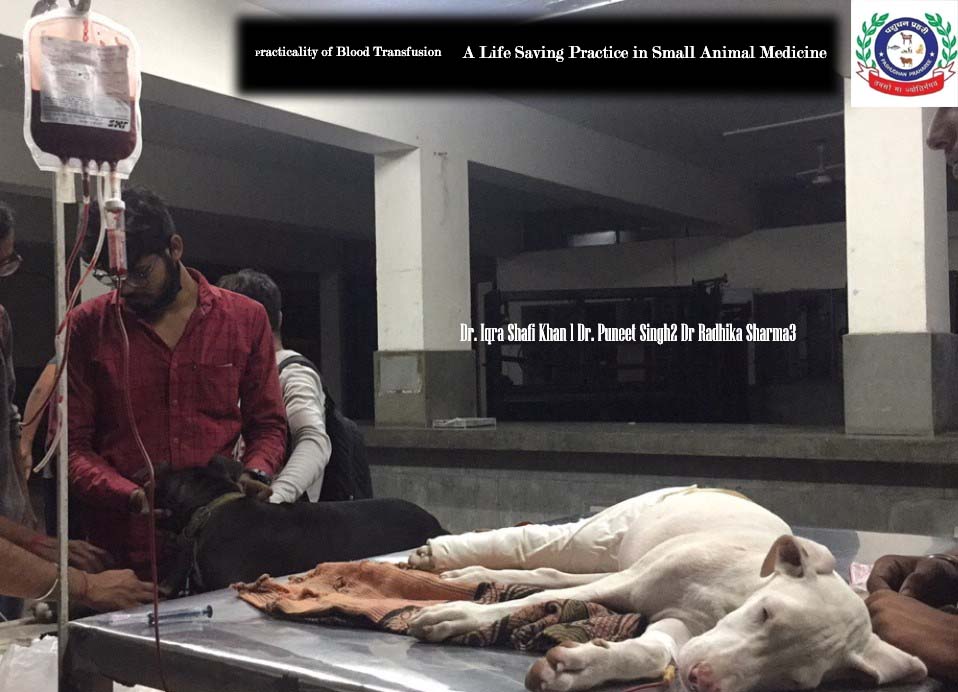Practicality of Blood Transfusion: A Life Saving Practice in Small Animal Medicine
Dr. Iqra Shafi Khan 1 Dr. Puneet Singh2 Dr Radhika Sharma3
1PhD. Scholar, Department of Veterinary Medicine, Guru Angad Dev Veterinary and Animal sciences University Ludhiana 141004
Email:khaniqrashafi@gmail.com
2M.V.Sc. Scholar, Department of Veterinary Medicine, Guru Angad Dev Veterinary and Animal sciences University Ludhiana 141004
3PhD. Scholar, Department of Livestock Product and Technology Guru Angad Dev Veterinary and Animal sciences University Ludhiana 141004
Blood transfusion therapy has become more approachable and common in veterinary practice. It has become an integral part of lifesaving and advanced treatment for critically ill patients. Hemoglobin, packed cell volume and total erythrocyte count are important factors that help to evaluate the need whether patient needs a transfusion or not. Blood transfusions are crucial to save patients with acute blood loss, to improve oxygenation capacity and patient’s capability to overcome the underlying diseases. The first successful transfusion of blood from one dog to another was first reported in 1665 by Richard Lower. Donor day is celebrated worldwide every year on 14th June by World Health Organization (WHO). In animals with chronic blood loss (eg, gastrointestinal mucosal ulceration and bleeding), blood transfusions can stabilize the patient while diagnostics and treatment regimens are implemented.
Indications for transfusion
- When HCT has fallen rapidly to below 20% in dogs and 15% in cats
- Deficiency of blood constituents
- Autoimmune hemolytic anemia
- Trauma and surgeries
- Babesiosis
- Toxicities
- Pulmonary Hemorrhages
- Hepatic diseases
- Kidney failure
- Pancytopenia’s
- Pyometra
Blood types
DEA 1.0 system contains 3 antigens, DEA 1.1, DEA 1.2, and DEA 1.3. Dog erythrocyte antigen 1.1 is the most common antigen in this system and most antigenic blood group in dogs and is expressed by the RBCs of approximately. Overall 13 canine blood groups have been described and eight DEA (Dog Erythrocyte Antigen) types have been recognized. Other non-standardized antigens within DEA such as Dal and the recently described Kai 1 and 2 have been reported Crossmatching
The major cross matching involves the cross matching of donor RBCs with recipient serum, whereas, the minor matching is the cross matching of recipient RBCs with donor serum. Incompatibility could be noticed as hemolysis or agglutination.The major crossmatch tests checks the alloantibodies in the recipient’s plasma against donor cells, whereas the minor crossmatch test looks for alloantibodies in the donor’s plasma against the recipient’s RBC’s.
- Collect anticoagulated blood and serum from donor and recipient.
- Wash RBC in 0.9% saline solution and prepare 5-10% RBC suspension.
- Put 2 drops of donor cells and 2 drops of recipient serum and mix (major coss match).
- In the second tube, put 2 drops of recipient cell and donor serum (minor cross match).
- Controls are set with serum and cells of donor and recipient separately.
- Incubate for 30 min at room temperature, centrifuge for 1 min at 1000 rpm.
- Examine the tube for hemolysis, shake the tubes to resuspend cells and check for hemagglutination microscopically.
- Incompatibility in minor cross match can be used if other compatible donor is not available.
Compatible Major cross match of donor and recipient

Selection of Donors
Blood donors should be healthy (neutered male or spayed female are preferred). The PCV of dogs and cats should be greater than 40% and 35% respectively. Blood donors should be young adult, lean, and good tempered animals, and weigh at least 23 kg for dogs (to donate 450ml); have no history of prior transfusion; have been regularly vaccinated and are healthy as determined by history, physical examination, and laboratory tests (complete blood cell count, chemistry screen, and fecal parasite examination every 6-12 months) and a recommended age of 1-8 years.
Blood collection
Blood is collected aseptically by gravity from the jugular vein over 5-10 minute period. Blood is collected in a commercial blood bags containing citrate-phosphate-dextrose-adenine (CPD-A1) as an anticoagulant that represents a closed collection system which minimizes the risk of bacterial contamination Dogs can donate every 3 weeks as long as they receive good nutrition. Client owned dogs usually donate blood every 2-3 months.
Transfusion of blood
The actual requirement of blood is calculated by using either of the following formula
Amount of donor whole blood = Body wt. (kg) × Recipient volume (dog 90 ml or cat 66 ml) × (Desired PCV–PCV of recipient) /PCV of Donor
As, a general rule 2ml/kg of whole blood will raise the PCV by 1 percentage point or Hb level by 0.3g/dL.
Blood transfusion in anemic patient
Blood administration to recipient
Blood should be transfused preferably using a commercially blood infusion sets that have an in-line microfilter. The route preferred for the transfusion is slow intravenous but sometimes intra intramedullary (or intraosseous) infusion at the trochanteric fossa (or other sites) may be used when no venous access can be obtained while the intraperitoneal administration is not recommended. The initial infusion rate should be approximately 0.25 ml /kg for the first 30 minutes, after which the rate can be increased if no reactions are seen. The entire volume should be administered within 4 hours to prevent functional loss or bacterial growth.
Transfusion reaction and its managements
Transfusion reactions are adverse effects resulting from the administration of blood products and classified as immunologic or nonimmunologic and acute or delayed. Most reactions are acute and some can be delayed reactions, such as delayed immune-mediated hemolysis, anuria, neonatal isoerythrolysis, post-transfusion purpura and transmission of an infectious disease to the patient. Delayed haemolytic reactions can occur days to weeks post transfusion. The administration of dexamethasone (1mg/kg IV) and chlorpheniramine (0.5mg/kg IV, SC, IM) is done immediately.
Conclusions:
Transfusion therapy plays an important role as it acts as a supportive emergency treatment for the dogs with anemia. The main aim of transfusion is to replace the missing constituent of blood and, in the case of anemia, haemorrhage, haemolysis or ineffective erythropoiesis, to increase oxygen carrying capacity.
References:
Manual of Veterinary Transfusion medicine and blood banking. KenichiroYagi and Marie K Holowaychuk
Manual of Canine and feline hematology and Transfusion medicine Micheal Day, Andrew Mackin and Janet Littlewood
Small animal internal Medicine Richard William Nelson, and C. Guillermo Couto


